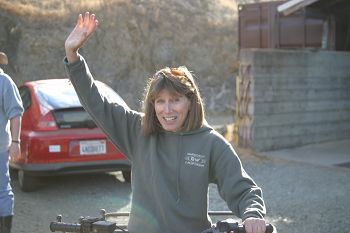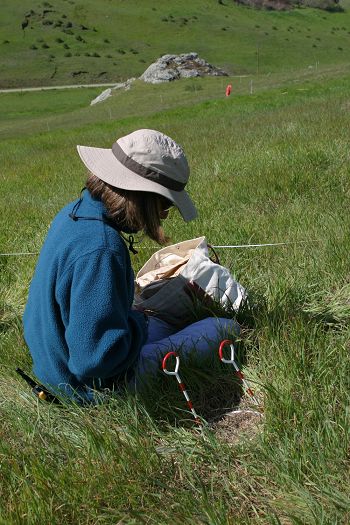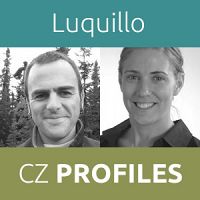Critical Zone Profile - WHENDEE SILVER (ecosystem ecologist, Professor)
Whendee Silver explores the effects of anthropogenic climate change and land use on the structure and function of the ecosystems that living creatures depend upon for clean air, clear water, food, and fiber. Whendee’s research focuses on three general and related topics. The first is how energy and nutrients cycle through the environment and how these cycles shape the structure and functioning of ecosystems. The second is the production and emissions of greenhouse gases, and the third is climate change mitigation through land management. For this research Whendee is exploring the potential of composted organic material (food waste, agricultural waste, and green waste) as an amendment to grasslands to enhance carbon sequestration, while simultaneously lowering greenhouse gas emissions from the urban and agricultural sectors.
“The critical zone links the rocks with the atmosphere and everything in between.” —Whendee Silver
By studying the critical zone we are looking back in time to the component parts that shaped the environment we see today. We can also study the present by following the flow of water, energy, and materials to and from the air and rocks, through soils and plants and microbes, and to and from streams and rivers. We can then use the information we learn from the past and present to help predict future conditions. This will allow us to better plan, adapt, and prepare for what the future holds.
I grew up in southern California near a national forest. After school we would ride our bikes to the river and hike up the canyon to boulder or catch lizards. Having nature as a playground definitely shaped my interest in CZO science.
Whendee Silver and colleagues explore patterns in rooting depth in the critical zone of a montane tropical forest.
Some of the most dramatic changes I have witnessed in my lifetime have been in tropical forests. I began working in Costa Rican rainforests as an undergraduate in college. Through an internship with the Costa National Park Service, I had the opportunity to work with some of the top tropical ecologists of that time. I remember the forests of the national parks as being large and seemingly endless. You could literally lose yourself for days. As I continued to work in the tropics and in Costa Rica throughout my career, I witnessed the encroachment of land use to the edges of the parks and natural areas, until suddenly the parks seemed to be just patches of trees on a landscape that was nearly completely deforested.
Tropical forests are often called the lungs of the Earth because of their capacity to convert large amounts of carbon dioxide into fixed carbon in their tissues. Our work in tropical forests has focused on the retention and loss of carbon. Plants capture carbon as carbon dioxide gas from the atmosphere and convert it into solid and liquid forms in their tissues. These tissues then form the food for microbes and animals (including humans!). Our work has shown that microbes have evolved many different ways to consume the carbon that plants produce, including the consumption of carbon in the absence of oxygen (i.e., anaerobic digestion). Understanding carbon inputs via plants, carbon storage in plants and soils, and carbon losses to the atmosphere helps us determine the capacity of the land to hold carbon. The more carbon stored on land, the less that is in the atmosphere contributing to global climate change.
Tropical forests and wetlands are large natural producers of greenhouse gases. The gas produced forms part of the background concentrations we see in the atmosphere. These gases are critical to keep out planet warm enough for life; too much greenhouse gas warms the planet past the natural levels (aka global warming). We are studying the factors that control greenhouse gas emissions from tropical forests and wetlands. We are also studying how emissions are changing as a result of climate change and human impacts on the environment. Our research has found that composting organic waste significantly lowers emissions by increasing plant growth and soil carbon sequestration (Ryals et al. 2014), while leading to large carbon offsets.
CRITICAL ZONE OBSERVATORIES (CZO)
As an ecologist, the critical zone network has exposed me to a wide range of research from other disciplines—which has helped to broaden my understanding of the environment. For example, interactions with geologists and geochemists have led me to expand my research from the surface to deep soils (5+ meters!). In this work we are exploring where the signature of the surface disappears, how far down in the critical zone we detect the effects of trees, and how important the deep soil environment is for the plants and animals that live on the surface.
The CZO program has provided funding to build collaborations across geologists, ecologists, soil scientists, and hydrologists to explore the critical zone across a range of different environments. While most of my CZ research is focused in the tropical forests of Puerto Rico at the Luquillo CZO, I have also participated in cross-CZO activities that are allowing us to test the generality of our ideas and discoveries. The National Office continues to be instrumental in turning a set of separate research programs into the Critical Zone Network. They provide communication resources, data management resources, outreach opportunities, and synthesis and integration.
Many CZ scientists work closely with land managers, and some research sites are on county, state, or federal lands—helping to facilitate the transfer of information and technology. In the Luquillo CZO, one of our co-PIs is a Forest Service employee (Dr. Grizelle Gonzalez), and other collaborators work with the USGS (Dr. Jamie Shanley and Dr. Martha Scholl). These collaborations facilitate information exchange, helping researchers conduct management- and policy-relevant science and ensuring that scientific research is made available to both managers and policy makers.
I think that communicating science to a broader audience is absolutely necessary to educating the public and policy makers about the importance of the critical zone. I also think field trips and field experiences, even if only for an hour of two, go a long way in helping people understand the importance of the research critical zone scientists do.
:: By Linda Copman, staff writer ::
Whendee Silver, Professor of Ecosystem Ecology and Biogeochemistry
Whendee Silver and colleagues explore patterns in rooting depth in the critical zone of a montane tropical forest.
Collecting plant biomass samples from the top of the critical zone in California.
Related News
Explore Further







